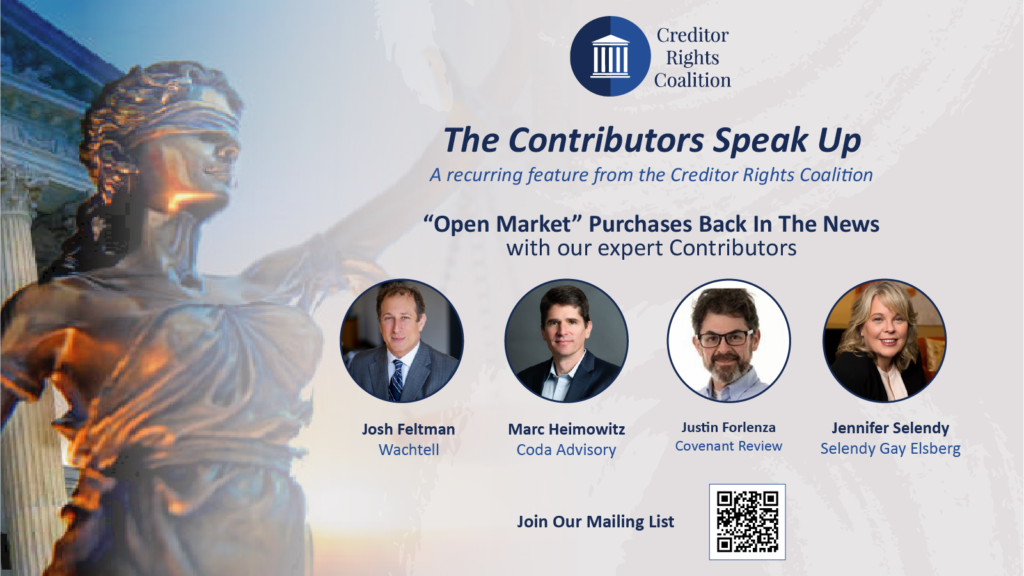Open Market Purchases Back In The News

Our panel of experts weigh in on one of the most controversial topics in the credit markets today. Can distressed borrowers pick and choose winners and losers when engaging in aggressive “liability management” transactions? The answer to this question revolves around what constitutes an “open market” purchase. As noted by Covenant Review Senior Analyst Justin Forlenza, “there is a stark contrast between the ‘open market’ purchase interpretations offered by [Bankruptcy Court] Judge Jones and [Federal District Court] Judge Failla.” Bankruptcy Judge Jones relied on his experience in concluding that the term clearly includes the contemplated transactions in the Serta case. Jones has not issued an opinion but relied on the “sophisticated” nature of the parties in handing down his decision from the bench. Forlenza notes that it is “difficult to see what the bounds of an ‘open market transaction’ would actually be based on the Bankruptcy Court’s interpretation.” In contrast, District Court Judge Failla was much more skeptical and relied on the common understanding of the term “open market.”
The Loan Sales & Trading Association held its own seminar on the topic this past week and has issued a Market Advisory defining open market purchases as requiring the repurchase to be brokered or through a trading platform and set at quoted market price.
How did our Contributors come out? Marc Heimowitz of Coda Advisory (and former sell-side head) notes that an “‘open market’ purchase requires lack of price or term distortion due to undue coordination between either the borrower and lenders, or among lenders.” Heimowitz concludes that “a group-conditioned trade essentially creates a privately negotiated transaction (perfectly permitted in the absence of a pro rata provision) similar to a tender, not an open market transaction.” Contributor Jennifer Selendy of Selendy Gay Elsberg references veteran distressed debt market expert Marti Murray’s view that “an open market purchase would generally be understood in the industry to mean a purchase of bank debt for cash in the secondary market conducted at arm’s length at or close to the prevailing market price.” The answer to this question has wide-ranging implications for flexibility of distressed borrowers (and their mostly sponsor parents) to engage in aggressive liability management techniques to manage their capital structures.
What are the legal and policy implications at play here? Joshua Feltman of Wachtell looks at this interplay from the perspective of the $1 trillion+ private non-syndicated debt market where these types of transactions have failed to gain traction. Feltman notes that this could indicate “a competitive advantage for non-syndicated credit.”
When asked about the market response to these transactions, we heard a variety of views. Forlenza looked at the market response from the primary and secondary markets with the primary market mostly foreclosing these types of transactions going forward while 67% of loans in the secondary market still allowing for non pro rata exchanges utilizing the open market purchase provision.
Feltman here looked at cooperation agreements as the secondary market correcting midstream. But, the end result still looks unclear. Why are we more likely “to get cooperation agreements among super majorities supporting ratable treatment than … to get cooperation agreements among bare-majority coalitions who want to position themselves to offer the most value possible to sponsors by extracting the most value possible from 49.9% of similarly situated creditors” he notes. That’s a scary prognostication.
What about the worrying trend of these exercises becoming a road to nowhere with bankruptcy filings for TPC Group and Serta Simmons and Envision reportedly on the horizon. While some of our Contributors questioned the “economic utility” of these transactions, others noted that many of these transactions were products of COVID and at least bought some needed time at worst.
Even if there were an easy solution to these perplexing problems, Forlenza notes, “clever lawyers and finance professionals will always be scouring the 200+ page agreements in order to find potential ways to preserve value for equity holders.”
Whack-a-mole continues.
